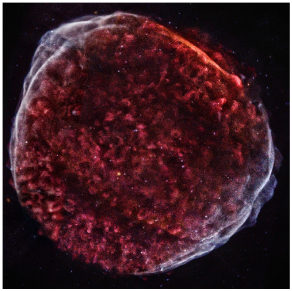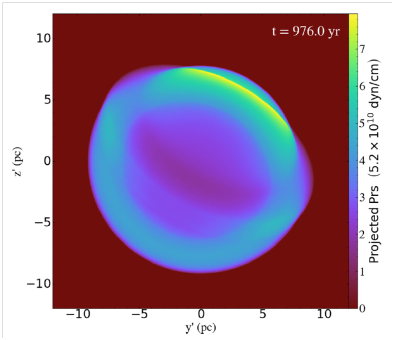基于3D HD 数值模拟揭示了超新星遗迹SN 1006特殊形态形成机制
多波段观测结果显示超新星遗迹SN 1006具有较为特殊的形态。例如,在硬X射线波段,壳层呈现为双翼形结构,在东北及西南部分亮。除此之外,遗迹边界还存在明显的凸起。在射电、光学和软X射线波段,西北部有一明亮的丝状结构。假设遗迹周围介质存在不连续的密度分布,方军团队基于三维流体力学模拟方法,较好地解释了东北及西南部分遗迹边界的凸起以及西北部分明亮丝状结构的形成原因。
该研究成果“Numerically investigating the morphology of the supernova remnant SN 1006 in the ambient medium with a density discontinuity” 已发表于《皇家天文学月报》(Monthly Notices of the Royal Astronomical Society,文章链接: https://ui.adsabs.harvard.edu/abs/2019MNRAS.tmp.2807F/abstract)

图1. Chandra望远镜获得的SN 1006图像。

图2、数值模拟获得的压强投射(projected pressure)图。
Numerically investigating the morphology of the supernova remnant SN 1006 in the ambient medium with a density discontinuity
Multiband observations on the type Ia supernova remnant SN 1006 indicate peculiar properties in its morphologies of emission in the radio, optical and X-ray bands. In the hard X-rays, the remnant is bilateral with two opposite bright limbs with prominent protrusions. Moreover, a filament has been detected at the radio, optical and soft X-ray wavelengths. The reason for these peculiar features in the morphologies of the remnant is investigated using 3D HD simulations. With the assumption that the supernova ejecta is evolved in the ambient medium with a density discontinuity, the radius of the remnant's boundary is smaller in the tenuous medium, and the shell consists of two hemispheres with different radiuses. Along particular line of sights, protrusions appear on the periphery of the remnants since the emission from the edge of the hemisphere with a larger radius is located outside that from the shell of the small hemisphere. Furthermore, the northwest filament of SN 1006 arises as a result of the intersection of the line of sight and the shocked material near the edges of the two hemispheres. It can be concluded that the features that the protrusions on the northeast and southwest limbs and the northwest filament in the morphologies of SN 1006 can be reproduced as the remnants interacting with the medium with a density discontinuity.
